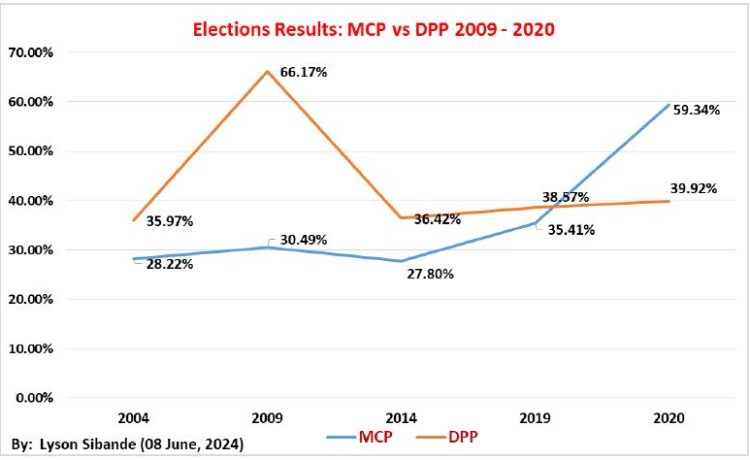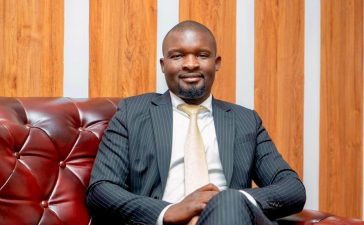Sibande, in his argument on why the DPP will lose in 2025, begins by highlighting that the party has been struggling since 2014, giving the MCP a competitive advantage. Below is a graphical presentation, along with analysis, interpretation, and predictions from the analyst:
This graph is a simplistic way of analyzing and interpreting elections data for the given period. The impact of alliances, electoral systems, demographics, candidates and other variables have not been given special attention as would be expected. However, the results pattern itself is a product of the interaction of all those variables over the given period. Hence the analysis and interpretation of the pattern is reliable to determine strength of DPP and MCP and their likely performance in the 2025 Elections.
DPP did not actually contest in 2004. However, Bingu wa Mutharika was still the Candidate for 2004 and 2009.
Hence, the graph starts with 2004 as the baseline to show the sharp rise and shocking fall of DPP between 2004 and 2014.
BACKGROUND
On 10 February 2020, I plotted and shared this same Graph to advise that DPP was a party that was declining while MCP was a steady and rising party. I concluded by predicting that in any election after 2019, MCP candidate was going to win because the MCP’ blue line in the graph was definitely going to cross the DPP line.
Now, I have plotted the graph again to give you further analysis, interpretation and prediction to prepare both the MCP and DPP for the 2025 Elections.
ANALYSIS OF RESULTS: REFER TO THE GRAPH
• In 2009: DPP (Democratic Progressive Party) dominated the election with 66.17% of the vote, showcasing a strong hold on the electorate. In contrast, MCP (Malawi Congress Party) received 30.49%, indicating a weaker position. DPP got two times the votes of MCP which came second in that election.
• 2014: DPP saw a dramatic decline in its voter share, dropping to 36.42%. DPP lost 50% of its voter share though the party won the elections. This sharp decrease reflected voter dissatisfaction and significant political shifts. Though MCP lost again, the party’s voter share did not decrease much. It only slightly dropped to 27.80% suggesting relative stability for the party.
• 2019: The results showed a narrowing gap between the two parties. Though DPP won the elections again, it only slightly increased its share with just about 2% points from 36.42% to 38.57%, while MCP saw a significant rise of 8% points to 35.41%. This shows that MCP grew in strength and performed better than DPP between 2014 and 2019 despite losing elections.
• 2020: MCP experienced a remarkable surge, obtaining 59.34% of the votes. While the historic win for MCP was influenced by the Tonse Alliance especially UTM votes and also the change in the electoral laws, it also indicates a major shift in voter preference towards MCP and further weakening of DPP if we look back at 2009 where DPP alone could get more than the 59.34% combined votes of Tonse Alliance.
The weakening of DPP is further confirmed by the fact that it also got into an alliance with UDF but only realized a marginal increase of around 1% point from 38.57% to 39.92%.
INTERPRETATION OF RESULTS
• DPP: The shocking sharp decline from 2009 to 2014 gave DPP a fatal wound that the party has not recovered from until today and there is no any sign of recovery any time soon. DPP’s graph from 2014 shows more of a straight line meaning that the party has not been growing despite winning elections with narrow escapes.
• MCP: The steady performance from 2009 to 2019, followed by a dramatic increase in 2020, suggests effective party strategies, growing voter support, unwavering loyal voter support, and possibly successful campaign efforts. The leap in 2020, despite the alliance votes, still speak more about MCP ability to take advantage of DPP’s decline.
PREDICTION FOR 2025 ELECTIONS
• MCP: Given the substantial increase in voter support MCP appears to be on a strong upward trajectory. This trend is likely to continue and MCP could solidify its dominance in the 2025 elections.
However, MCP needs to consider strategic alliance partnerships to avoid gambling with the 50% +1 electoral system. MCP must also address keys issues of leadership, governance and socio-economic woes affecting Malawians, and complete some flagship infrastructure development for campaign purposes.
• DPP: To regain its leading position, DPP will need to analyze the factors behind its decline and address them effectively. One of the issues to seriously consider is the Party’s leadership. Peter Mutharika (APM) took over the party from Bingu at 66% and dropped it to 36%. For close to 10years, APM has failed to push DPP back to its former might.
The change for a better DPP starts with APM changing himself. Other strategies, could include revitalizing the party’s image, addressing voter concerns, and developing policies that resonate with the electorate across the regional and tribal divides. Without significant changes, DPP may struggle to beat MCP especially now that MCP is government.
All other factors constant, that graph shows DPP will lose the 2025 elections.













